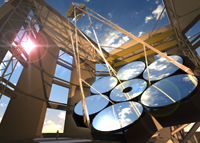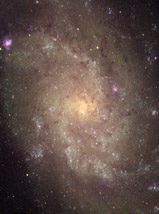| Giant Magellan Telescope Project | ||||
|
The Giant Magellan Telescope consortium has begun to design and build the first of the next generation, extremely large telescopes. The Giant Magellan Telescope (GMT) is based firmly on the heritage of the highly successful Magellan telescopes, which, thanks to their superb site and excellent design, routinely produce the best images of the current generation of ground-based large telescopes. The GMT will continue in this tradition, and will offer sharp images over wide fields in natural seeing, and with seeing enhanced by ground layer adaptive optics. In addition, the GMT will routinely produce diffraction-limited images with powerful adaptive optics systems designed into the telescope. GMT will be a powerful tool for addressing the key astrophysical problems of its era, beginning in approximately a decade. The GMT's primary mirror is formed from seven 8.4 meter diameter segments; a single on-axis segment is surrounded by six identical off-axis segments. GMT will have the collecting area of a single 22 meter mirror and the resolution of a single 24 meter diameter mirror. With a Gregorian secondary producing a final focal ratio of f/8, GMT will have an image scale of 1 mm per arcsecond. GMT's primary focal ratio of f/0.7 allows a very compact telescope structure. GMT will likely be located at the existing Las Campanas Observatory, a superb site that is already home to the 6.5 meter Magellan telescopes. The GMT Consortium currently includes the Carnegie Observatories, Harvard University, the Smithsonian Astrophysical Observatory, the University of Arizona, the University of Michigan, the University of Texas at Austin, Texas A&M University, and the Australian National University. The GMT Project conducted a very successful Conceptual Design Review in February 2006, and is currently entering its Design Development Phase. A great deal of additional material is available at the GMT Project's web site. The review documents for the Conceptual Design Review are available at this site, including the current scientific case for GMT.
Project Links Giant Magellan Telescope
People Daniel Fabricant, Nelson Caldwell, Scott Kenyon Andrew Szentgyorgyi, Brian McLeod Warren Brown, |
 Artist's Rendering of the GMT | |||




